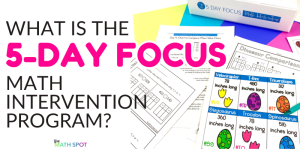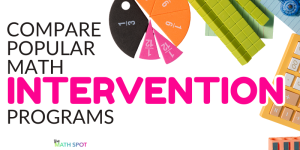This is one of the most common questions I get from teachers, especially interventionists and upper elementary classroom teachers: What do I do when my student is struggling to keep up in tier 1 because they are two or three years behind in math skills? The question usually goes something like this:
“My students are working on decimals, but I have a student who still really struggles with basic addition and subtraction. What should I do?”

I get it. You’re in a fifth-grade classroom, your Tier 1 instruction is focused on grade-level content like adding and comparing decimals, and you’re staring at a data report that shows a student is functioning more like a second or third grader in math. It feels like there’s no time, no space, and no clear path forward.
But my answer is always the same:
If you’re not going to teach them the skill they missed… who will?
And if it’s not happening now… when?
Those gaps don’t close on their own. If a student didn’t master addition or subtraction facts two or three years ago, and no one has intervened since, that gap is still sitting there, wide open and holding them back.
Sometimes teachers try to split the difference.
They say, “Well… what if I just teach addition within decimals? That way they’re sort of doing Tier 1, and sort of working on their gaps too.”
And while that may feel like a good compromise, it’s actually a much harder way to go about it.
Let me explain with a quick story.
My daughter is 4 1/2 years old. She wants to read chapter books so badly.
Her big brother reads chapter books, and the desire to read “Sparkle Piggies Carrot Chaos” is real. But here’s the thing: she’s still working on simple consonant-vowel-consonant words like “cat” and “hop.”
Now technically, we could try to help her read by opening up a chapter book and hunting through it for those CVC words. She’d get some practice that way.
But it would be clunky. Slow. Frustrating.
She’d spend more time lost than learning.
The far better approach?
Target the exact skill she needs right now. Help her actually learn to read those CVC words in the most direct, effective, age-appropriate way. Then, when she’s ready, those chapter books will be so much more manageable to work through!
It’s the same with math.
Trying to teach a student how to add whole numbers through a decimal unit is like trying to teach early reading skills through a chapter book.
It’s not that it can’t be done.
It’s that it shouldn’t have to be done that way.
If you’re seeing a foundational skill gap — like addition, subtraction, place value, or fact fluency — go back. Teach that skill directly. Give the student what they actually need, right now, in a way that helps them build confidence and clarity.
That’s not lowering expectations.
That’s good instruction.
And it’s the fastest way to move them forward.
Would you like help figuring out where to start?
The 5-Day Focus Math Intervention curriculum was designed for exactly this kind of situation — short, focused units that target the foundational skills your students need most, using a systematic approach that is as simple as it is effective.
[Learn more about 5-Day Focus here.]





